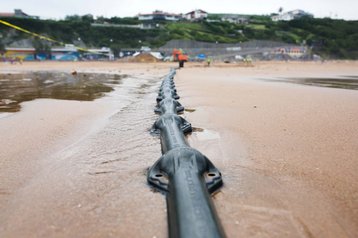The Cable Landing Station (CLS) colocation is where the networks live today. As an example, consider the petabytes per second being transported across the Atlantic Ocean into the US from Europe and South America - physically coming in through submarine cables.
This traffic needs a home and the CLS enables carriers to provide the diverse private ‘roads’ to carry that data. There are hundreds of thousands of miles of submarine cables traversing the globe with over 90 percent of the world’s international data transmitted across them. It is critical to global communications to eliminate unnecessary points of failure and shore up potential for security breaches.
Shore thing
Carrier-neutral submarine capabilities empower customers with options when choosing which cables will transport their data to key landing points. When a colocation data center campus is physically located at the meeting point of multiple submarine cable landings linking three continents, international connectivity is just a single cross-connect away.
The result is a high-resilience, low-latency network with direct interconnection options for service providers, enterprises, carrier-neutral operators and cable companies. Customers can further diversify and plan their international connections with clarity and accuracy, eliminating any transport uncertainty.
When a number of submarine cables land directly at a CLS colocation campus, this enables enterprise, content, financials, media, government, and communications providers to have maximized redundancy, reduced latency and better quality connections with fewer international points of failure, fortifying the protection of their international data traffic.
Meanwhile, network operators, by establishing a Point of Presence (PoP) at a CLS colocation campus, can design reliable architecture with diversity to other PoPs around the globe, once again with fewer points of failure and better service quality as well as lower operational costs.
The direct connectivity that supports customer diversity requirements shouldn’t be limited to just multiple submarine cable access capability. Access to multiple backhaul providers for connectivity to core markets - in the US, to Ashburn, Chicago, Dallas, North Carolina, Philadelphia, and other cities - bypassing common points of network failure such as New York, Northern New Jersey, and Miami.
In the modern CLS model, the cable landing station campus is the de facto hub, providing better access to connectivity, low latency, and high capacity.
For one out of three enterprises, a single hour of downtime can cost anywhere from $1 million to $5 million, according to a recent Gartner survey. In fact, network outages experienced by North American organizations alone result in revenue losses of $700 billion per year, so claims a report by IHS Inc. (NYSE: IHS).
As bandwidth demands continue to spike upward - the Cisco Visual Networking Index predicts that annual global IP traffic will reach 3.3 ZB per year by 2021, a three-fold increase from two years ago - new submarine cables and expansions of existing networks will become necessary, and not just linking major global hubs but second tier, emerging and underserved markets as well.
The CLS hub of tomorrow will not only offer access to submarine cable systems, but also provide the terrestrial backhaul needed to get beyond the landing point and out into the hands of the companies delivering the data, provide faster on-ramps to cloud infrastructure and power communications more reliably. Now that’s solid ground.


